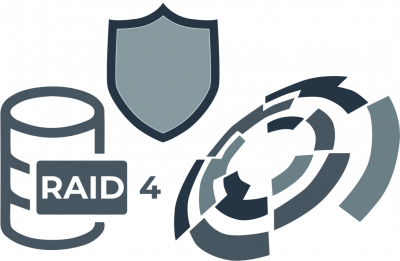How to Perform RAID 4 Data Recovery
Here you will find out:
- what is RAID 4
- why RAID 4 can fail and how it can be fixed
- how DiskInternals can help you
Are you ready? Let's read!
What is RAID 4?
In general, RAID is a disk bundle of several hard disks, which is necessary to improve the reliability of data storage and increase the speed of data read/write.
This essay will focus on RAID 4, one of the raid levels. The data distribution method used in this arrangement is striping at the block level over many drives with a separate parity disk.
This array can be easily expanded and there is no need to completely rebuild the entire RAID, but it only provides reliability and performance will remain the same or even degrade.
Considering this article further, you will learn not only about the advantages and disadvantages, but also about other important nuances of RAID 4.
How Does RAID 4 Work?
RAID 4 is configured like this: The array distributes block-level data across all disks in a RAID configuration. Then this thread writes parity information to one dedicated disk.
RAID 4 Performance
Because RAID 4 writes data to all disks, it can be read from any disk. Thus, RAID 4 offers improved random read operations, but write operations are a bit slow (since the parity bit is written to one disk).
In addition, the speed depends on which blocks are executed in parallel read requests.
Advantages and Disadvantages Of RAID 4
The main advantages of this array are:
- Improved parallel read performance.
- Small storage overhead.
- RAID 4 disks do not need to synchronize the disk spindles, so installation is easy.
The main disadvantages of the array under consideration include the following:
- RAID 4 disks do not need to synchronize the disk spindles, so installation is easy.
Low speed of simultaneous write operations, since parity information is written to one disk.
RAID 4 failure reasons
RAID 4, with all its positive aspects, can fail and you risk losing all the accumulated data. Because RAID 4 includes multiple hard drives, the likelihood of data corruption increases, and if even one hard drive is damaged, the entire array will need to be rebuilt. It is known that a hard disk does not last forever and sooner or later its service life will pass and it will need to be replaced due to physical wear, system or hardware errors, etc. Therefore, you will have good software on your desktop for recovering data from an array.
Keep in mind that when you recreate or delete a raid, all information from the disks will inevitably be deleted. Therefore, before these steps, first save all the necessary information (if any), and then conduct experiments.
Note: learn more about RAID controller!RAID 4 data recovery with DiskInternals
DiskInternals RAID Recovery software for Windows is the same tool that is better and faster than any other software to recover RAID 4 and beyond. The application recovers files from any RAID level connected to a dedicated RAID controller such as Adaptec, DDF-compliant devices, Silicon RAID controllers, etc. This is where file recovery from Microsoft RAID software takes place using the built-in Recovery Wizard.
The app has a free preview as well as many unique and useful features. It necessarily supports Unicode filenames and multi-level folders, ignoring Windows restrictions, exporting data to local or remote locations, and more.
Use the instructions for DiskInternals RAID Recovery to work on your computer:
1.Download and run RAID Recovery™ on your PC, after opening the application, select the desired array to search for data.
2. Then select the scanning method: full search or quick search, during which the program automatically checks the state and operation of the file system and disks, array and recovers files where possible.
After scanning, you will have read access to the files - this is a free preview. If everything suits you and you are satisfied with the work done, buy a license for RAID Recovery™ now on the website and you will be able to export the selected files to any suitable storage.


